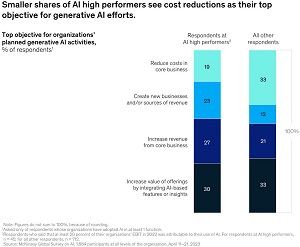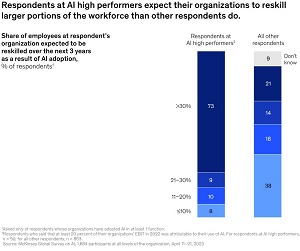News
How 'High Performer' Firms Benefit from AI Embrace, While Others Don't
Amid research indicating that some organizations fully embrace advanced AI and use it to benefit the business more than others do, a new report explains what these leaders are doing differently.
The new survey-based report published Aug. 1 by management consulting firm McKinsey & Company is titled "The state of AI in 2023: Generative AI's breakout year." One part of the sprawling report discusses how these AI leaders -- called "high performers" by McKinsey -- approach AI differently from less successful organizations.
The firm has actually been tracking high performers for years, well before the advent of OpenAI's ChatGPT chatbot and the generative AI craze it started late in 2022. For example, the firm's 2021 report discussed high performers and how they approach advanced AI differently -- though in those days "advanced AI" meant machine learning operations (MLOps), not generative AI. High performers are described as organizations at which respondents attribute at least 20 percent of earnings before interest and taxes (EBIT) to their use of AI.
Here's a snippet from the 2021 report: "With adoption becoming ever more commonplace, we asked new questions about more advanced AI practices, particularly those involved in MLOps, a best-practice approach to building and deploying machine-learning-based AI that has emerged over the past few years. While organizations seeing lower returns from AI are increasingly engaging in core AI practices, AI high performers are still more likely to engage in most of the core practices. High performers also engage in most of the advanced AI practices more often than others do."
It was a similar story in the 2022 report (still before ChatGPT), which indicated high performers achieved superior results mostly by boosting top-line gains, being more likely than other orgs to report that AI is driving revenue, though they also report cost reductions.
Here's a snippet from the 2022 report: "High performers are more likely than others to follow core practices that unlock value, such as linking their AI strategy to business outcomes. Also important, they are engaging more often in 'frontier' practices that enable AI development and deployment at scale, or what some call the 'industrialization of AI.'"
And then came ChatGPT and generative AI, and the 2023 report.
"These organizations that achieve significant value from AI are already using gen AI in more business functions than other organizations do, especially in product and service development and risk and supply chain management," the new report says. "When looking at all AI capabilities -- including more traditional machine learning capabilities, robotic process automation, and chatbots -- AI high performers also are much more likely than others to use AI in product and service development, for uses such as product-development-cycle optimization, adding new features to existing products, and creating new AI-based products. These organizations also are using AI more often than other organizations in risk modeling and for uses within HR such as performance management and organization design and workforce deployment optimization."
The Data
Here are a few charts with related McKinsey commentary that illustrate how high performers achieve business benefits from going all in on generative AI.
-
"High performers' gen AI efforts are less oriented toward cost reduction, which is a top priority at other organizations. Respondents from AI high performers are twice as likely as others to say their organizations' top objective for gen AI is to create entirely new businesses or sources of revenue -- and they're most likely to cite the increase in the value of existing offerings through new AI-based features.
 [Click on image for larger view.] Less Emphasis on Cost Reduction (source: McKinsey & Company).
[Click on image for larger view.] Less Emphasis on Cost Reduction (source: McKinsey & Company).
-
"Respondents at AI high performers most often point to models and tools, such as monitoring model performance in production and retraining models as needed over time, as their top challenge. By comparison, other respondents cite strategy issues, such as setting a clearly defined AI vision that is linked with business value or finding sufficient resources."
 [Click on image for larger view.] Different Challenges (source: McKinsey & Company).
[Click on image for larger view.] Different Challenges (source: McKinsey & Company).
-
"AI high performers are expected to conduct much higher levels of reskilling than other companies are. Respondents at these organizations are over three times more likely than others to say their organizations will reskill more than 30 percent of their workforces over the next three years as a result of AI adoption."
 [Click on image for larger view.] More Reskilling (source: McKinsey & Company).
[Click on image for larger view.] More Reskilling (source: McKinsey & Company).
Other high performer traits marked by McKinsey include:
- AI high performers are more than five times more likely than others to say they spend more than 20 percent of their digital budgets on AI.
- High performers use AI capabilities more broadly throughout the organization.
- Respondents from high performers are much more likely than others to say that their organizations have adopted AI in four or more business functions and that they have embedded a higher number of AI capabilities.
- For one example related to the item above, respondents from high performers more often report embedding knowledge graphs in at least one product or business function process, in addition to gen AI and related natural-language capabilities.
Don't Forget MLOps
Notably, MLOps is still important in the post-Gen AI era, at least for McKinsey.
"The findings offer further evidence that even high performers haven't mastered best practices regarding AI adoption, such as machine-learning-operations (MLOps) approaches, though they are much more likely than others to do so," said the report in discussion about the second item above. "For example, just 35 percent of respondents at AI high performers report that where possible, their organizations assemble existing components, rather than reinvent them, but that's a much larger share than the 19 percent of respondents from other organizations who report that practice.
"Many specialized MLOps technologies and practices may be needed to adopt some of the more transformative uses cases that gen AI applications can deliver -- and do so as safely as possible. Live-model operations is one such area, where monitoring systems and setting up instant alerts to enable rapid issue resolution can keep gen AI systems in check. High performers stand out in this respect but have room to grow: one-quarter of respondents from these organizations say their entire system is monitored and equipped with instant alerts, compared with just 12 percent of other respondents."
In addition to the report section discussing how leading companies are already ahead with Gen AI, other sections of the report were titled:
- It's early days still, but use of gen AI is already widespread
- AI-related talent needs shift, and AI's workforce effects are expected to be substantial
- With all eyes on gen AI, AI adoption and impact remain steady
Here is the methodology for the report: "The online survey was in the field April 11 to 21, 2023, and garnered responses from 1,684 participants representing the full range of regions, industries, company sizes, functional specialties, and tenures. Of those respondents, 913 said their organizations had adopted AI in at least one function and were asked questions about their organizations' AI use. To adjust for differences in response rates, the data are weighted by the contribution of each respondent's nation to global GDP."
About the Author
David Ramel is an editor and writer at Converge 360.